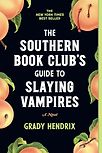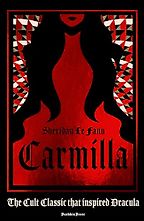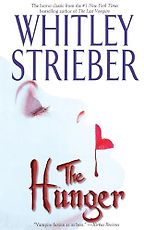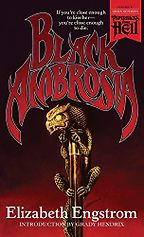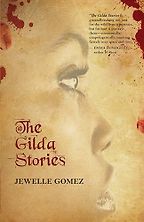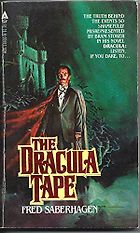Could you tell us about the history of vampires in fiction?
Vampires as we know them really appeared around the early 18th century in Serbia. They’ve always been associated with plagues and pandemics. Serbia was very war-torn at the time, and disease was breaking out everywhere. No one could figure it out. Every night, people in your house would get weaker and weaker, and the very old and the very young would die first, and no matter what you did, you couldn’t stop it. You could lock the doors, the windows, you could build a fire, you could do anything – and still, every day, they were weaker. And then you’d go to the cemetery with everyone and bury them, and everyone who went would get sick…
So the idea of vampires overlapped with pandemics. There are some accounts of the Habsburg Empire’s Imperial Army in the early 18th century being asked to deal with vampire outbreaks in a couple of small villages. and one of the medical officers who went on one of these expeditions wrote a report that was supposed to be for army eyes only, and of course that leaked out. Suddenly, there was a giant vampire craze in the middle of the 18th century.
The Earl of Sandwich named one of his racing horses Vampire. There were rumours that Louis XV of France was a vampire, using the blood of children to cure his daughter’s leprosy. Later, Karl Marx and Friedrich Engels were obsessed with vampires – you find vampire metaphors all through Das Kapital, and Engels wrote about the “vampire property-holding class” in his Condition of the Working Class in England, and talks about how capital is “dripping with blood” that it has sucked from the worker.
The first book about vampires was John Polidori’s The Vampyre, which everyone assumed was written by Lord Byron. It wasn’t written by Byron, it was written by his doctor, but Byron wasn’t shy about not not taking credit for it; and Polidori, the poor guy, was never really associated with it. It got adapted into plays in Paris which became big hits, and was imported to England which led to a glut of vampire plays in the early 19th century. Varney the Vampire was the very famous serialized vampire tale that ran all through the middle of the 19th century. And then came Carmilla in 1872, and lots and lots of vampire short stories… What’s really fun about this period of vampire fiction is that we see lots of psychic vampires and energy vampires. The energy vampire in the comedy series What We Do In The Shadows is right out of the 19th century. There are tons of these stories. Blood of the Vampire is a famous novel about an energy vampire by Florence Marryat, published in 1897 – the same year as Bram Stoker’s Dracula. So Stoker was kind of late to the party.
We’ve already touched on your first choice, from this earlier period. Could you introduce us to Carmilla?
Carmilla is by the Irish writer Sheridan Le Fanu, and it was first published around 1872. Carmilla gave us, firstly, the trope of the lesbian vampire, which just goes on and on. I mean, Hammer Films practically made sexy sapphic vampires a sub-genre in the ’60s, and it continues today. But he also gave us a vampire that preys on human kindness.
The story is very simple. It’s about a young girl who lives with her father out in the middle of nowhere, and there’s a carriage accident in their drive one day. In the carriage is a mother, who says, “Can you take care of my daughter for a while?” because she has to rush off to some European location. So they take Carmilla into the house, and Carmilla and the hostess are both teenage girls, and they become obsessed with each other. The hostess is repulsed by Carmilla, but attracted to her. And what follows is a very graphic, very overt, sexual vampire seduction.
The reason I love Carmilla so much is it really makes your hair stand up. I mean in the shocking, heavens-to-Betsy-I-need-to-open-a-window sense. It is some pretty sexy, very lurid stuff. And some of the writing is absolutely beautiful.
Vampires weren’t really sexy until later. Dracula is not a sexy vampire. He has hairy hands, he’s old, he smells bad. But Carmilla is the vampire who exploits our desire to be desired. When someone else is hungry for you, that kind of activates you – makes you take risks. It makes you walk around with your neck exposed. Their desire for you makes you want to be desired. And where that ends with a vampire is with you getting consumed, literally.
What makes vampires different from zombies or werewolves or ghosts is that vampires are the monster that looks like us. They’re the ones that can move amongst us undetected. They’re the closest thing we have to a monstrous form of a serial killer. And they exploit our desire to be desired– they bring out the self-destructive urge in us.
Your next choice takes us forward to 1981, and it’s another sexy vampire – which is more standard by then?
Yes, by the time The Hunger came out, vampires had already gotten sexy – they started their association with sex in 1931 with the film version of Dracula. Before the 1931 Universal horror movies, the scare films that people went to see were venereal disease scare films, and often the plots of those were that young girls would meet an older, cultured man from the big city at some roadhouse, and he would lead them astray and then disappear, leaving them with a venereal disease. Or a young man would find a more experienced woman, say in France, and he would bring home a disease to his family. Dracula the film really takes a lot of cues from venereal disease scare films. And then you had the Hammer films of the late ’50s and into the ’60s, where Dracula was still evil, but he was becoming this romantic, brooding, gothic presence; then came Dracula on Broadway with Frank Langella, and the comedy Love at First Bite in the ’70s, and Blacula. That was when Dracula fully became a romantic partner and someone who was sexually desirable.
Fascinating. So into this comes your second choice, Whitley Strieber’s novel The Hunger.
Strieber was a really, really good horror writer. His horror was a little pulpy, but it was very well crafted and often had a lot going on under the surface. Strieber is the most famous in the States because in 1985 he claimed he was abducted by aliens and wrote a book called Communion about his experience. From then on he became a non-fiction writer trying to expose the truth about aliens, and selling workshops and seminars that would help other people who’d been abducted, and he became this UFO guru. But before then, he was a really good journeyman horror writer.
The Hunger is about a love triangle featuring a woman called Miriam Blaylock, who would later be played by Catherine Deneuve in the movie adaptation with David Bowie as her lover. Miriam turns her romantic partners into vampires, and she’ll keep them with her and treat them as an equal. But she’s immortal, and they’re not. They live a very, very long time, but after a while they need more and more blood, and the blood works less and less, and they begin to age. And the thing that I love is that Miriam has always made a promise to her lovers that she’ll keep them with her forever, so they don’t die – they just turn to these little withered husks, and she keeps them locked in suitcases and trunks in her attic. It really is one of the creepiest images, I think, in all of vampire fiction: this attic full of chained up trunks, rustling with the husks of all her dried up lovers. She has literal baggage that she drags around with her.
It’s a book that perfectly captures the late ’70s, early ’80s romantic vampire. It goes very dark. And like Carmilla, it walks this line between the vampire being someone you desire, but you know is bad for you. No one needs a werewolf; no one needs a ghost; but you need a vampire. It’s similar to drug or alcohol addiction. And it’s a part of victim-abuser relationships too, where the waters are muddied, and it’s hard to find the exact line where it turned from love to abuse. Victims often can’t put their finger on that moment, and so they blame themselves. Horror does such a good job of making metaphors literal, and I think that’s one reason people are so attracted to vampire stories – we have a hard time talking about the relationship between abusers and the abused, between what we need and what destroys us, and vampire stories give us a good way to look at that from different angles.
Pandemic, addiction, abuse – they’ve been a fertile metaphor over the years.
Yes.
So in this story vampires confer vampire-hood via a bite, which I’ve always thought of as quite standard, but it seems to be optional. What are the essentials, to qualify as a vampire?
The big decision writers have to make when they invent a vampire is: is it supernatural, or is it biological? If it’s supernatural, then they’re scared of crosses and religious symbols, they can’t cross running water, they can turn into a bat – that kind of thing. If they are more biological, then it’s the feeding on blood that’s central. You can’t turn into a bat, where does all that mass go? Of course you can cross running water, and why would you be scared of a cross? So it really depends on that choice.
When you boil it down, the two things that differentiates vampires from all other monsters are that they look human and can walk among us undetected, and that they feed on humans. So they need humans as much as they destroy humans. There’s a problem called the vampire problem in macroeconomics: if every vampire turns someone they bite into another vampire, but they have to preserve a feeding pool or else they’ll drive themselves into extinction, what’s the tipping point where they have destroyed their food source and will begin population decline?
Haha, I love the idea of vampires having Malthusian woes…
Yes, exactly.
Let’s talk about your third choice. Stoker’s Dracula isn’t on your list today, but we do have this reimagining by Fred Saberhagen – please introduce The Dracula Tape.
The reason people still read Dracula for fun is that it’s a really great book. There have been so many re-imaginings of it – there’s Kim Newman’s Anno Dracula; Tim Lucas’ The Book of Renfield; even Stoker’s great-grandnephew Dacre Stoker has written a retelling. But my favourite is Fred Saberhagen’s The Dracula Tape, which is a bit forgotten now.
It’s a retelling of Dracula from Dracula’s point of view. One of the beautiful things about Bram Stoker’s book is everyone gets a point of view – we have Jonathan Harker’s point of view, and Mina Harker’s, and Dr Seward’s – everyone’s except Dracula’s. This book gives us Dracula’s point of view, and it is fabulous. Dracula’s line is, “Look, guys, I’m just this nice European count. I just wanted to come to England. I met this woman, we fell in love, and everyone acted like a xenophobic monster. I’m the victim here. I didn’t kill Mina Harker; these idiots who didn’t understand blood types killed her by giving her a blood transfusion she didn’t need with the wrong type of blood. These guys are religious fanatics. They hate women, they’re sexist pigs, they fear foreigners, and I’m just a guy trying to make my way in the world…” It’s so wounded, and you can just hear him rolling his eyes between the lines as he writes, as he gives his version of the story.
Vampires are often depicted as malevolent – they can be romantic, they can be attractive, they can be sexy – but I love the idea of a vampire who’s just totally and completely fed up with humans and thinks we’re all a bunch of idiots. If he’s immortal, then of course from his point of view, we’re all morons.
Are you meant to believe him – are you persuaded?
Oh, absolutely you’re persuaded. And it’s funny, you actually see some of this getting picked up in later versions of Dracula. If you watch Francis Ford Coppola’s Bram Stoker’s Dracula, Van Helsing comes across as a fanatic – and that’s right out of The Dracula Tape, that wild-eyed faith in science. Let’s face it, if you were certain about science in 1897 you were certain about a lot of things that would be debunked in the next hundred years – like measuring skulls to demonstrate intelligence, and maternal impression. You see that interpretation again in the recent Nosferatu, where Willem Dafoe plays this wild-eyed, insane occultist version of a Van-Helsing-inspired character. So I think The Dracula Tape has permeated our culture. It’s not a very well-known book, but it’s slipped into the walls of the house of our culture, like a termite.
Your own vampire book is a totally original invention, not a re-write, but you’re obviously drawing on a lot of knowledge. I’d love to hear about your process. Could you start by introducing The Southern Book Club’s Guide to Slaying Vampires?
This is a book I wrote that came out in 2020 – right as the pandemic began, weirdly enough. I grew up with my mom’s book club. I think they’re celebrating their 49th year in existence, so they’ve been around forever. I really hated them when I was growing up. They were these women who came to the house, they were loud, I had to stay in my room… As I got older and started to know them as human beings, I realized that they’ve been through lives that oftentimes we never knew about as their kids. We didn’t know the things they had dealt with. For years, I had this idea for a book about a vampire moving to a small southern town where the only people who notice anything’s awry is this book club of middle-aged women. Everyone dismisses them, because everyone always dismisses middle-aged women, and they have to take on the task of facing him down. I thought, a vampire is ultimately responsible only to his appetite, and your mom is nothing but outside responsibilities: to her family, to her children, to her friends, everything. So it was pitting these two opposites against each other.
And it’s fabulous. How did you develop your approach to vampires?
I decided I would go with a more biologically oriented vampire. I didn’t want to get into the supernatural angle. The big thing I faced was, why is he drinking blood? The human blood supply is about nine thousand calories max, and you need a couple of thousand calories a day to live. That means a vampire is dropping two or three bodies a month, and if he’s going to live somewhere that makes no sense. Evolutionarily speaking, that would have been bred out of vampires a long time ago. But I thought he could be using the human body as a sort of dialysis machine, to filter his blood and cleanse it of impurities and toxins. That made a lot more sense.
Animals that feed on blood often have a numbing agent in their saliva, and sometimes a mild narcotic agent. So I thought my vampire could be like an intoxicant that his victims get addicted to. And it went from there.
The thing I was so astonished by is how much the image of the vampire overlaps with the image of the serial killer – this person who drifts into town and lives among us unsuspected, and preys on humans and toys with them and victimizes them.
Let’s turn to your fourth choice, Black Ambrosia by Elizabeth Engstrom. Could you tell us about it?
Elizabeth Engstrom is a writer I stumbled across when I was writing a book called Paperbacks From Hell, which is a history of the ’70s and ’80s paperback horror boom. Hundreds and hundreds of horror paperbacks filled bookstore shelves in the ’70s, ’80s and into the ’90s, before it all collapsed in 1995. I read a lot of these books to write my book, and a lot of these authors were out of print at the time. I picked up a book by Elizabeth Engstrom called When Darkness Loves Us, and it blew me away. Then I found Black Ambrosia, which also blew me away.
The story is about a young girl whose parents die. She hits the road, drifts around, rootless, and she gets attacked by these two men. But when she gets attacked, her vampiric powers suddenly manifest, and she kills them.
From there she drifts through America, going from town to town all through the Midwest. She’ll shack up with someone for a while, groom them, and use them as a lover and maybe someone to feed on before she kills them and moves on to her next. One of her victims, who she left barely alive, takes on the task of hunting her down and bringing her to justice.
But! There’s a funny trick in this book where there’s a paragraph or two at the end of every chapter from someone else’s point of view, and you realize that she might not actually be a vampire. She might just be a serial killer who’s delusional, and thinks she’s a vampire. And it’s really left up to the reader. I’ve talked to Elizabeth Engstrom, so I know what she thinks, and I know what I think; but it’s left up to the reader, in the book.
It is an astonishing book, and it’s a real tour of the dark side of 1980s America. I think a lot of people think of America in the ’80s as big hair and leg warmers and bands like The Bangles and The Go-Gos. But there was a darker side of America, of the Rust Belt, where the Midwest and these industrial towns were getting hollowed out. And all over the Midwest, there were unsolved crimes – the Ohio Circleville letter writer, the BTK killer, Jeffrey Dahmer. There was a dark, lonely side of America where people were becoming more and more isolated from each other, and there were people preying on them. Elizabeth Engstrom does such a good job of painting this world that became so economically hollowed out, and how it can so easily become a feeding ground for a vampire and become morally hollowed out as well.
You wrote an introduction for the recent reprint of this book, and in that you say that “vampire books obey different rules than horror novels”. Could you expand on that?
I talked to Melissa Ann Singer, who edited horror for Tor in the 1980s, ’90s, and 2000s, and she said that horror novels go in cycles, but vampire novels are always around. A horror novel can take on so many guises, but a vampire novel – and especially a vampire novel in the ’80s into the ’90s – began to become a very different thing from the horror novel. It often focused on this relationship between predator and prey. Post-The Vampire Lestat, which Anne Rice wrote in 1985, the vampire became very sexy and sexually attractive. So the vampire became this object of attraction, and vampire novels in the early ’90s began to cross over with romance novels, and became more romance than horror novels.
There were people doing that before, like Chelsea Quinn Yarbro, who did the Hotel Transylvania series about the Count of St Germain, which started in the ’70s and ran for decades. But it was really in the early ’90s that vampire novels became romance novels about a brooding Gothic hero redeemed by the love of a man or a woman, who was in turn transformed into something heroic by loving this vampire, this monster, despite their monstrousness. That’s what happens between Buffy and Angel, that’s what happens in Twilight. So really, in the ’80s and on into the ’90s, vampire books stopped being horror, and began to follow the rules of romance fiction.
Let’s turn to the ’90s then. Please tell us about The Gilda Stories by Jewelle Gomez.
The Gilda Stories have fallen a little out of fashion, but back in the 90s… man! They were assigned as much as Bastard Out of Carolina in gender studies courses, in women’s literature courses, in multicultural literature courses.
It’s about a black woman who’s escaped slavery, who gets transformed into a vampire by another woman and becomes her lover. She, in turn, becomes a vampire who transforms other women into her lovers and into vampires. The book follows her life over the decades. It starts in the 19th century, and then it keeps going into contemporary times.
But what I love is that it then keeps going into a near future world where vampires come out of the closet, so to speak, and become members of our society. What happens then? This is a book with such a breadth of imagination that really shows you what can be done with vampires. For every heterosexual vampire novel — a broody male vampire transformed by the love of a young woman — you have something like John Peyton Cooke’s Out For Blood, which is a gay vampire story from the ’90s, or The Gilda Stories, which are gay non-white vampire stories… In 1991, it was very ahead of its time.
Vampire stories can do anything. They can be about monsters, they can be about victims and victimizers; you can see them through the lens of a hetero romance, you can see them through the lens of a queer romance; you can see them through a non-white lens, you can see them through a colonial lens; you can see them in so many different ways. They can even, in one book, stretch across all those different relationships, all those different categories of sexuality, and even stretch into the future and become science fiction. You can go from historical fiction to contemporary horror fiction to science fiction, all in a single book.
Incredible! It sounds like there are many, many more out there we could have talked about…
Yes. If people want to dip into vampirism further, I’ll just mention two of my favourite out-there vampire stories with a very different kind of vampire. First, Mary E. Wilkins Freeman’s short story “Luella Miller.” Wilkins Freeman was an enormous writer, a huge bestseller around the turn of the last century, who has been forgotten today. She wrote this short story about a psychic, emotional vampire. People around her just get more and more exhausted, and she asks them for more and more favours, until they finally wither and die. I think we’ve all had a friend like that. Then there is Richard Matheson’s 1951 short story, “Dress of White Silk.” I don’t think it’s even 1000 words long. It’s such a great child vampire story, which really shows you what can be done in such a small space of time.
I’m waiting for my next big vampire book to come along right now. I feel like everything’s very much in the shadow of Twilight, so I’m waiting for someone to break some new ground soon…
Interview by Sylvia Bishop
April 6, 2025. Updated: October 31, 2025
Five Books aims to keep its book recommendations and interviews up to date. If you are the interviewee and would like to update your choice of books (or even just what you say about them) please email us at [email protected]
Five Books interviews are expensive to produce. If you've enjoyed this interview, please support us by donating a small amount.

